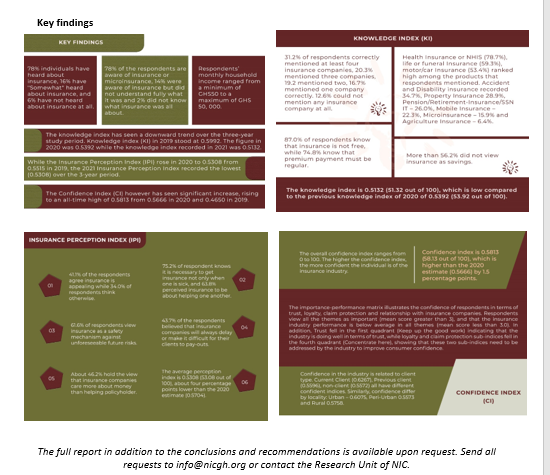“It’s hardly controversial to say that most people view their insurance providers with ambivalence. The overriding perception of insurance companies is that they’re needed, but not liked, relied on, but not trusted – James Eardley.”
The National Insurance Commission (NIC) was established under Insurance Law 1989 (PNDC Law 227), and now operates under ACT 2021 ACT 1061.The object of the commission is to ensure effective administration, supervision, regulation, and control the business of insurance in Ghana. Quite evidently, it is controversial to say that most people view their insurance providers with ambivalence. The overriding perception of insurance companies is that they are very needed, but not liked, relied on, but not trusted. As the foremost regulatory institution in charge of insurance and related matters in the country, the NIC makes policy decisions related to the industry based on research.
Against this backdrop, the NIC commissioned the first ever public perception, awareness, and confidence index in 2019 in conjunction with the Deutsche Gesellschaft für Internationale Zusammenarbeit GmbH (GIZ). In 2020, the NIC proceeded to conduct the second round of research with regards to the same indices as a way to keep track of progress. The third round, termed Phase 3, was conducted in 2021.
The Phase 3 round of research forms the basis for the current study in context. In general, consumer confidence – measured by the Consumer Confidence Index (CCI), is defined as the degree of optimism about the state of the economy that consumers of services, such as insurance services, are expressing through their activities of saving and spending. When consumers are confident in their futures, they tend to spend money and drive economic growth higher.
The Phase 3 round of research is particularly important because the year was marred by the COVID-19 outbreak and subsequent economic activity slowdown. According to research conducted by PWC on the effect of COVID-19 on insurance customers, there is a potential influence of COVID-19 on service preferences, loyalty to carriers, and attitudes toward auto, homeowner, life, dental and vision coverage, as well as retirement.
In short, financial stress correlates with dissatisfaction, hence insurance companies may draw inferences from this situation to alter, for example, insurance plans, provide alternative pricing and use digital technologies to make strides on the market although there is an overall economic slowdown due to COVID-19 and other socio-economic stressors. The current study revealed that knowledge index is 0.5132 which is lower compared to the 2020 average knowledge index of 0. 5392 – a 2.6% change.
Further, males (0.5296) scored a higher knowledge index than females (0.4874). The average perception attitude index was determined to be 0.5308, about four percentage points lower than the 2020 estimate, 0.5704. In this instance, current clients (0.5502) had a more positive view of insurance than previous clients (0.5292) and non-clients (0.5175).
More importantly, the average confidence index was 0.5813, which is higher than the 2020 estimate (0.5666) by 1.5 percentage points. Current client, previous client and non-client were indexed at 0.6367, 0.5596 and 0.5572 respectively. In terms of locality, the index scores were: Urban (0.6075), Peri-Urban (0.5573) and Rural (0.5758). Amid a difficult year, the various intentions targeted at enhancing public perception, awareness and confidence of insurance in Ghana has yielded positive results.
Some of these interventions include insurance awareness, education programmes across the seven regional NIC offices, agency training programmes, among others. The recommendations stated herewith, will support NICs ongoing intervention programmes to shore up public confidence, awareness and confidence of insurance in Ghana in the COVID-19 era.
The specific objectives outlined in the Phase 3 round of research include the following:
- Assess the general public’s perception and understanding of insurance concepts, products, and companies;
- Assess the general public’s knowledge of insurance concepts, products and companies;
- Assess the attitude of the general public toward insurance concepts, products and companies;
- Assess general public’s experiences regarding raising queries, complaints and disputes resolutions; and
- Identify issues that need to be addressed to improve public confidence.
Sample size and geographical spread
The sample size used for this study was 1613. The quota sampling approach was used to select the various samples by region based on a logical stratification process by ratio or population size of the region. Similarly, the quota sampling approach was used to stratify the population in the urban, peri-urban, and rural samples, based on the active (18-65) population density of all 16 regions of Ghana.
The age range of 18-65 was considered for the study; however, the statistical definition of active population (15-65) was used to calculate the sample size. Insurance holders were assigned a quota of 40% of the entire distribution, previous insurance holders were also assigned a 35% quota and non-policy holders were assigned a quota of 25%.
During data collection, the purpose sampling and data collection approach was employed to identify the potential clients, previous clients and non-clients in the selected urban, peri-urban and rural areas purposively selected for the study. Once the target locations were determined, the convenience sampling approach was used to conveniently select the respondents in a face-to-face manner – and selection was based on the respondents who were ‘close to hand’ and were willing to participate in the study.
Key findings
The full report in addition to the conclusions and recommendations is available upon request. Send all requests to [email protected] or contact the Research Unit of NIC.










